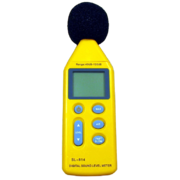Tondaj SL-814
 | |
| Status | supported |
|---|---|
| Source code | tondaj-sl814 |
| Connectivity | USB/serial |
| Frequency range | 31.5Hz - 8.5kHz |
| Measurement range (A) | 40dB - 130dB |
| Resolution | 0.1dB |
| Accuracy (94dB@1kHz) | 2dB |
| Frequency weighting | A, C |
| Time weighting | F, S |
| Website | tondaj.cn |
The Tondaj SL-814 (also referred to as TDJ SL814 sometimes) is a sound level meter with USB connectivity.
See Tondaj SL-814/Info for more details (such as lsusb -vvv output) about the device.
Hardware
Device:
- Main CPU: Atmel ATmega8/L (marking: "Atmel ATmega8L 8AU 1113D"), (datasheet)
- 8MHz crystal: 8.00ECSXR
- ?: 324 GZ15129
- 5V (100mA) low-dropout voltage regulator: Holtek HT7550-1# (datasheet)
- Trim potentiometer: Bochen 3296
USB cable:
Photos
Device:
USB cable:
See Device_cables#Tondaj_SL-814_cable.
Protocol
The device has a mini-USB connector for PC connectivity. It ships with a Prolific USB-to-serial cable (i.e. the Prolific chip is inside the cable) which can be attached to that connector.
The device accepts a simple command-based protocol over the (virtual) serial port, using a baudrate of 9600 baud, with 8e1 settings (8 data bits, even parity, one stop bit).
Commands / replies
Commands and replies can consist of multiple bytes, and always end with 0x0d.
| Name | Command | Reply | Comments |
|---|---|---|---|
| Init | 0x10 0x04 0x0d | 0x05 0x0d | It's unclear what exactly this command does, likely some kind of initialization. Data transfers also seem to work fine when it is omitted. According to the scheme below in the "Send key" case it might be a "key press", but there doesn't seem to be any visible or noticeable effect at all. E.g. it does not reset any of the settings (A/C, fast/slow, and so on) to their defaults. |
| Send key | 0x10 0xKK 0x0d | 0xKK+1 0x0d | This command has the same effect as if a certain key/button on the SL-814 had been pressed. The known value encodings for the key (0xKK) are: 0x20 = up arrow key, 0x30 = down arrow key, 0x40 = A/C key, 0x50 = fast/slow key. There doesn't seem to be a key code for the "MAX" button or the power button. Thanks to Chris Hoogenboom for the info about this command. |
| Get measurement | 0x30 0xZZ 0x0d | 0xAA 0xBB 0xZZ+1 0x0d | For a given command with 0xZZ value (0-255), the device returns 0xZZ + 1 as part of the reply (a simple "sequence number" mechanism which is apparently meant for the host as error-checking mechanism). |
Data reply
The first two bytes of the reply to the "get measurement" command (0xAA 0xBB) have the following format:
| Byte | Bit | Value |
|---|---|---|
| 0 | ||
| 7 | A/C measurement type. 0: A, 1: C. | |
| 6 | Unknown/unused. | |
| 5-4 | Level. 00: 40, 01: 60, 10: 80, 11: 100 | |
| 3 | Slow/Fast measurement mode. 0: Fast, 1: Slow. | |
| 2-0 | Value[10..8]. | |
| 1 | ||
| 7-0 | Value[7..0]. |
The actual measurement value seems to span 11 bits, and is encoded in BCD format. Example: If Value[10..0] is 436 (decimal), the corresponding measurement value is 43.6 dB.
Notes
The "MAX" mode on the device (which always keeps showing the highest measured value since the "MAX" button was pressed) only affects the value shown on the display. The values returned via USB upon the "get measurement" command, always show the current value, not the "MAX" one shown on the display.
Python script
Here's a quick Python script for getting the values out of the Tondaj SL-814.
#!/usr/bin/python3
# Tondaj SL-814 sound level meter Python script
# Copyright (C) 2012 Uwe Hermann <uwe@hermann-uwe.de>
# Released under the terms of the GNU GPL, version 2 or later.
import time
import serial
s = serial.Serial('/dev/ttyUSB0', baudrate=9600, parity=serial.PARITY_EVEN)
while 1:
# Query
s.write(bytes([0x30, 0x01, 0x0d]))
result = s.read(4)
print('%02x %02x %02x %02x' % tuple(result), end=' - ')
# A/C
ac = (result[0] & (1 << 7)) >> 7
print('A' if ac == 0 else 'C', end=', ')
# Slow/Fast
sl = (result[0] & (1 << 3)) >> 3
print('Fast' if sl == 0 else 'Slow', end=', ')
# Level
factor = (result[0] & ((1 << 5) | (1 << 4))) >> 4
print('Level: %d' % (40 + (int(bin(factor), 2) * 20)), end=', ')
# Value
val = ((result[0] & 0x7) << 8) | result[1]
tmp_str = '%d' % val
val_str = tmp_str[:-1] + '.' + tmp_str[-1:]
print(val_str + ' dB')
time.sleep(0.5)
s.close()
Example output:
09 af 02 0d - A, Slow, Level: 40, 43.1 dB 09 b9 02 0d - A, Slow, Level: 40, 44.1 dB 09 e9 02 0d - A, Slow, Level: 40, 48.9 dB 89 cb 02 0d - C, Slow, Level: 40, 45.9 dB 89 eb 02 0d - C, Slow, Level: 40, 49.1 dB 8a 6c 02 0d - C, Slow, Level: 40, 62.0 dB 82 99 02 0d - C, Fast, Level: 40, 66.5 dB 82 3c 02 0d - C, Fast, Level: 40, 57.2 dB 82 72 02 0d - C, Fast, Level: 40, 62.6 dB 92 85 02 0d - C, Fast, Level: 60, 64.5 dB 93 05 02 0d - C, Fast, Level: 60, 77.3 dB 92 68 02 0d - C, Fast, Level: 60, 61.6 dB a3 93 02 0d - C, Fast, Level: 80, 91.5 dB a3 93 02 0d - C, Fast, Level: 80, 91.5 dB a3 93 02 0d - C, Fast, Level: 80, 91.5 dB b3 f2 02 0d - C, Fast, Level: 100, 101.0 dB b3 f2 02 0d - C, Fast, Level: 100, 101.0 dB b3 f2 02 0d - C, Fast, Level: 100, 101.0 dB
Resources
TODO.























